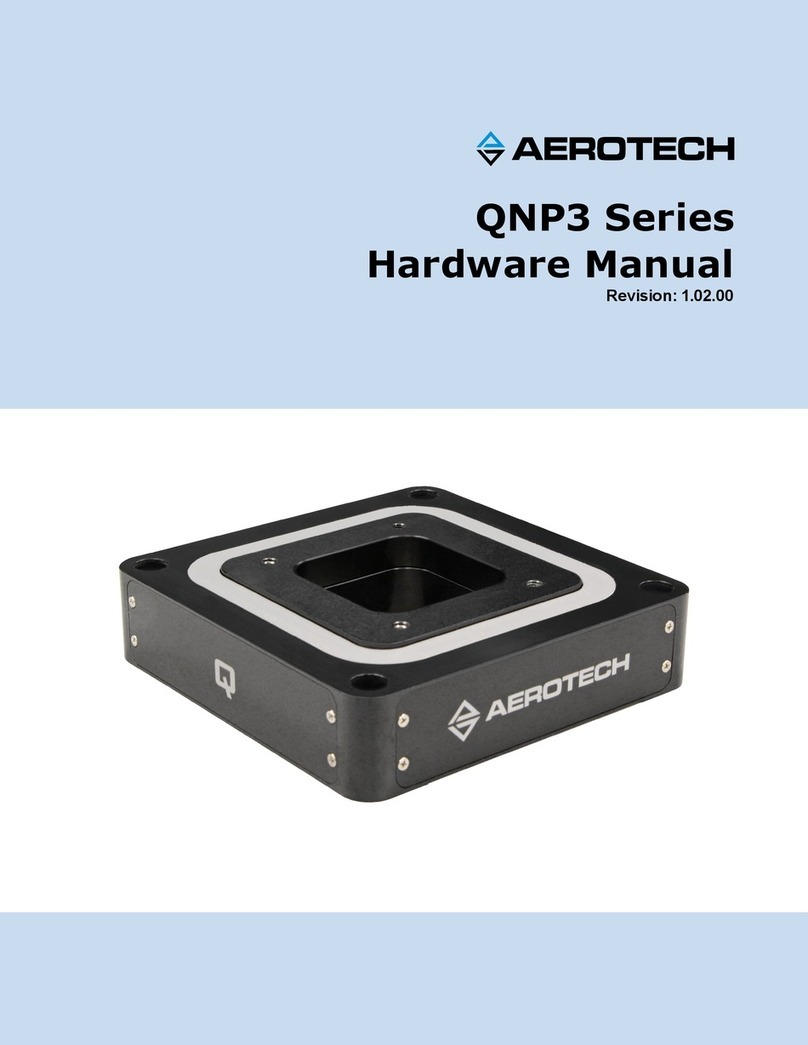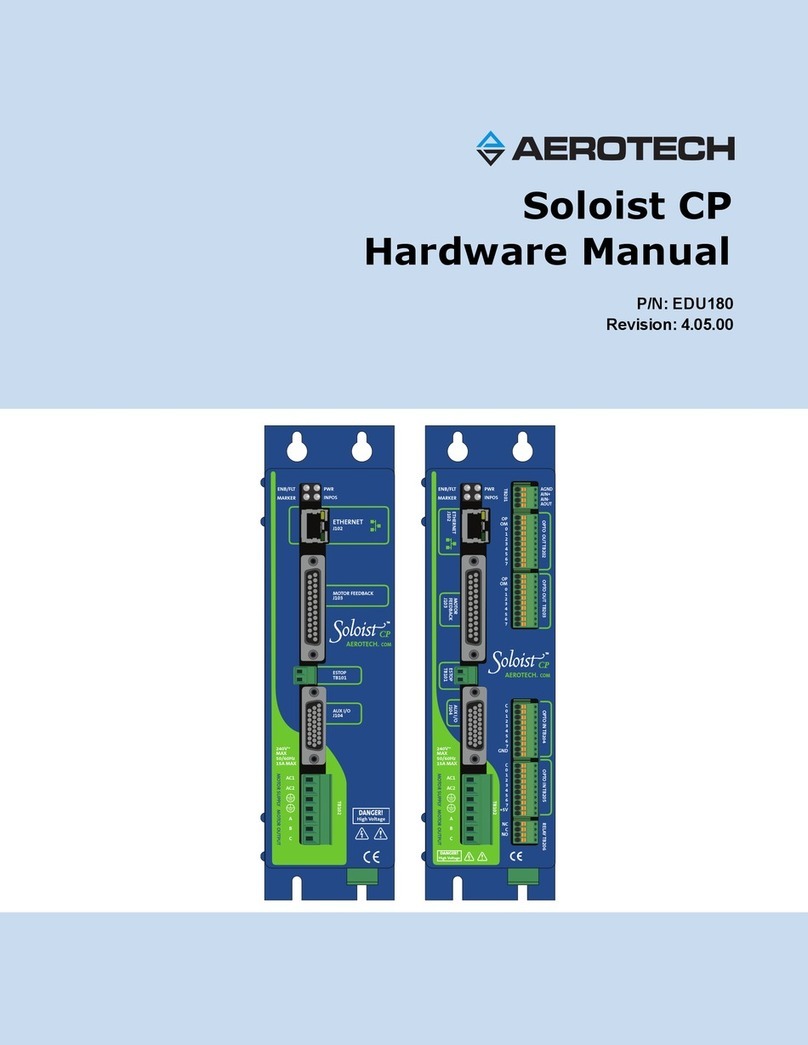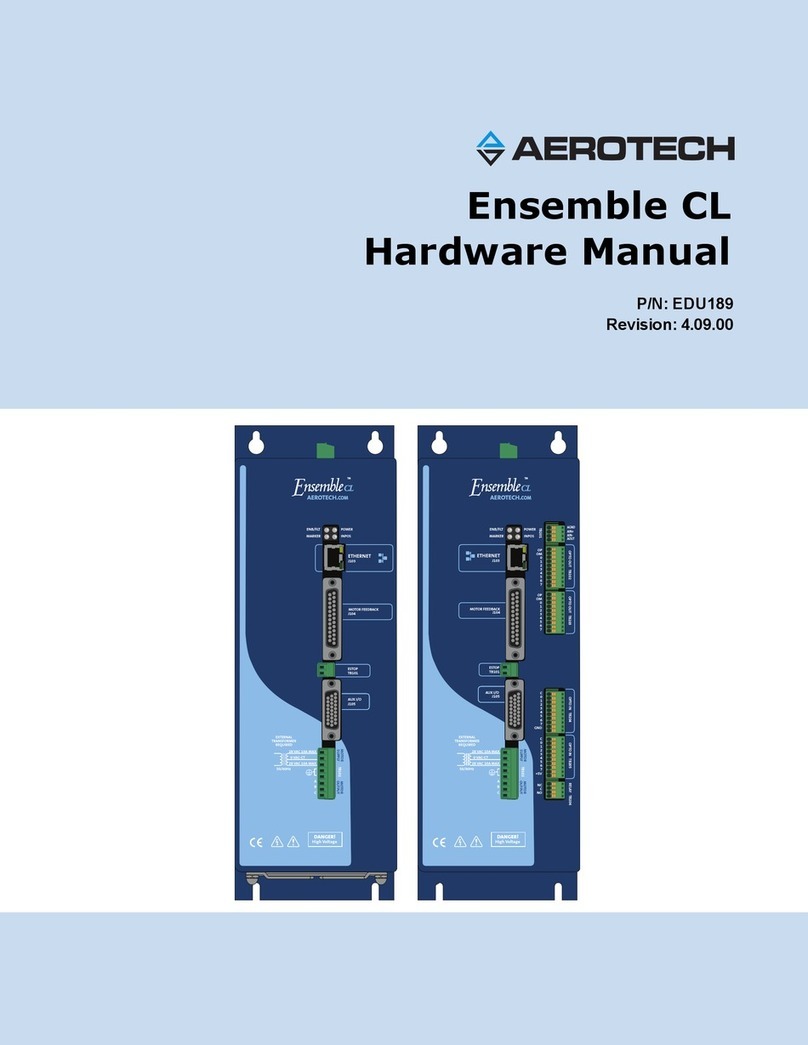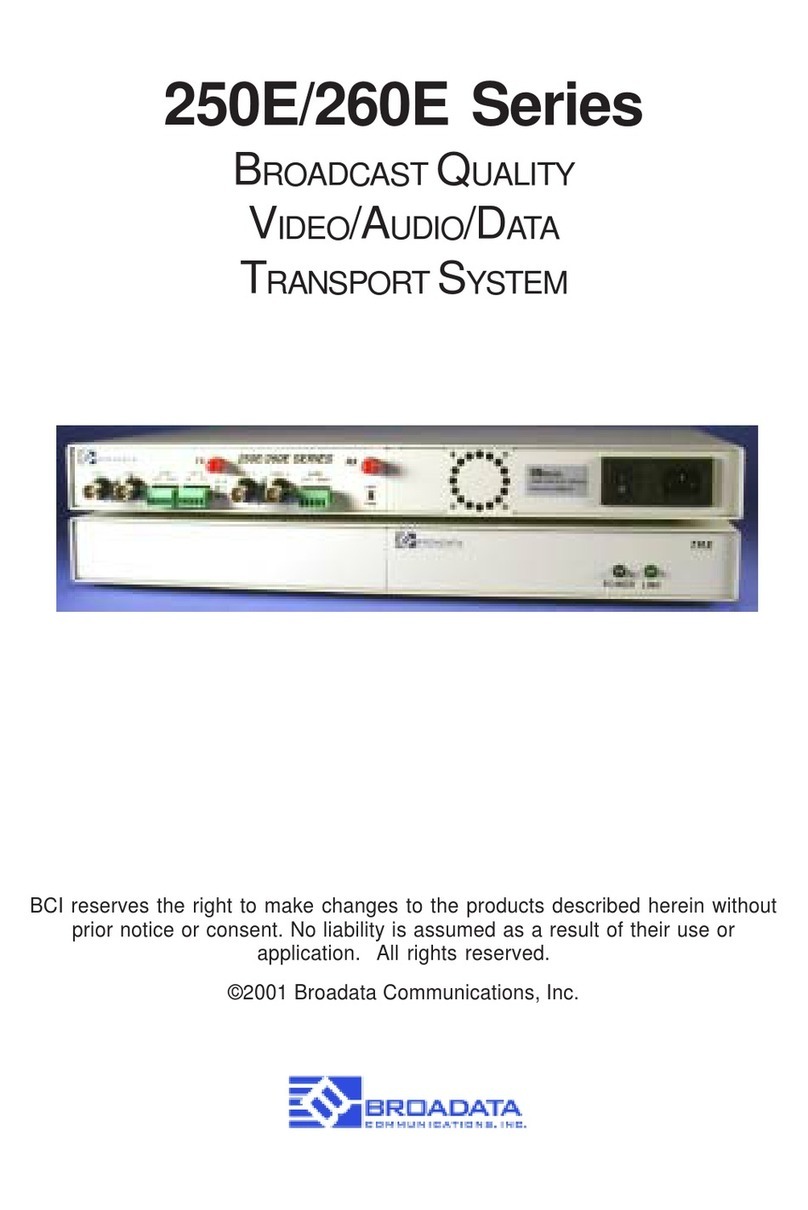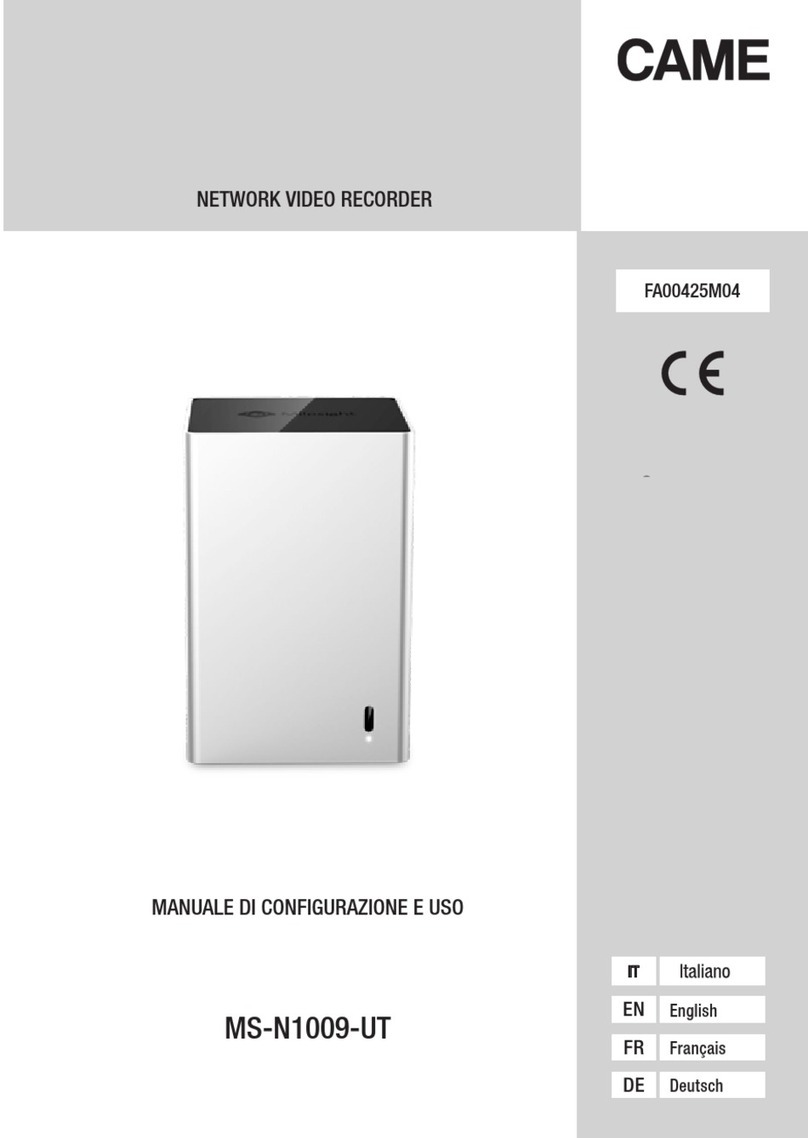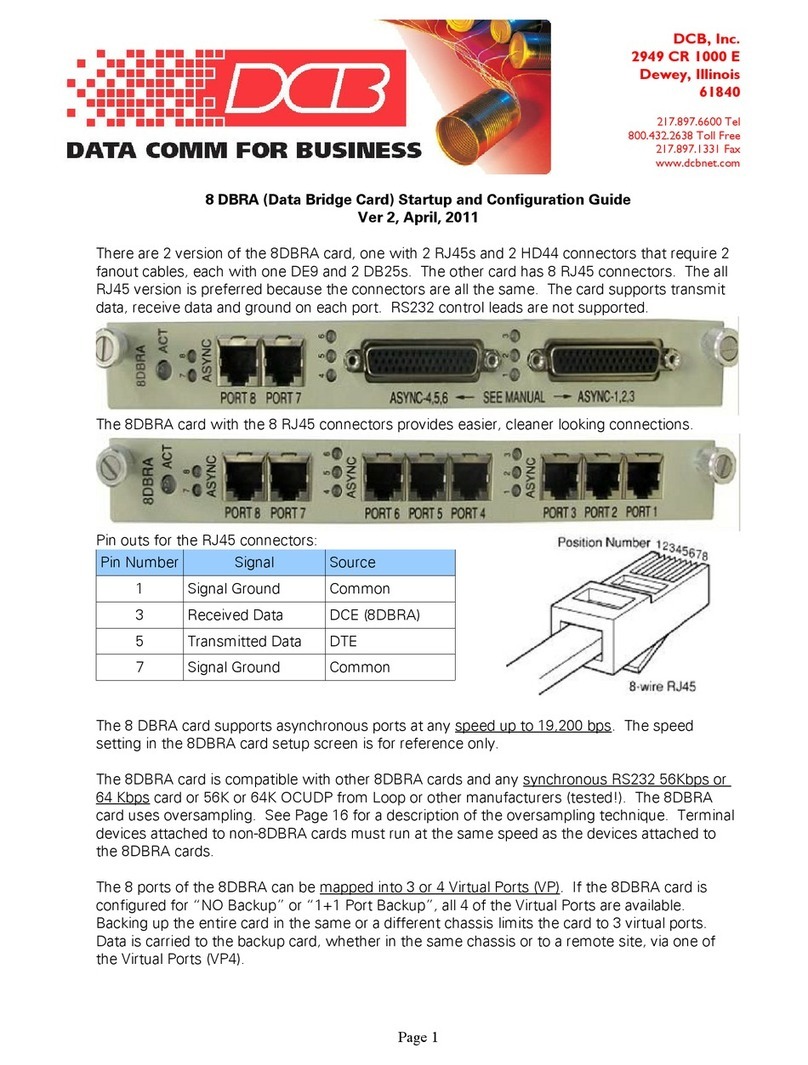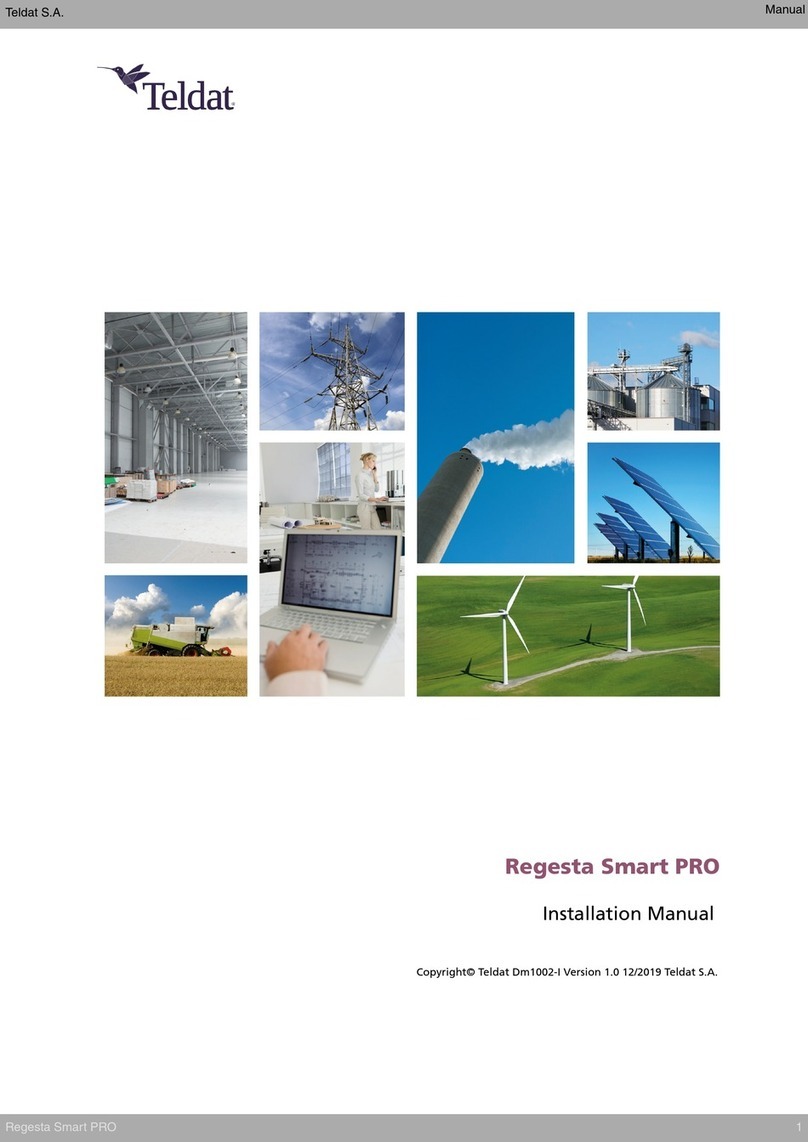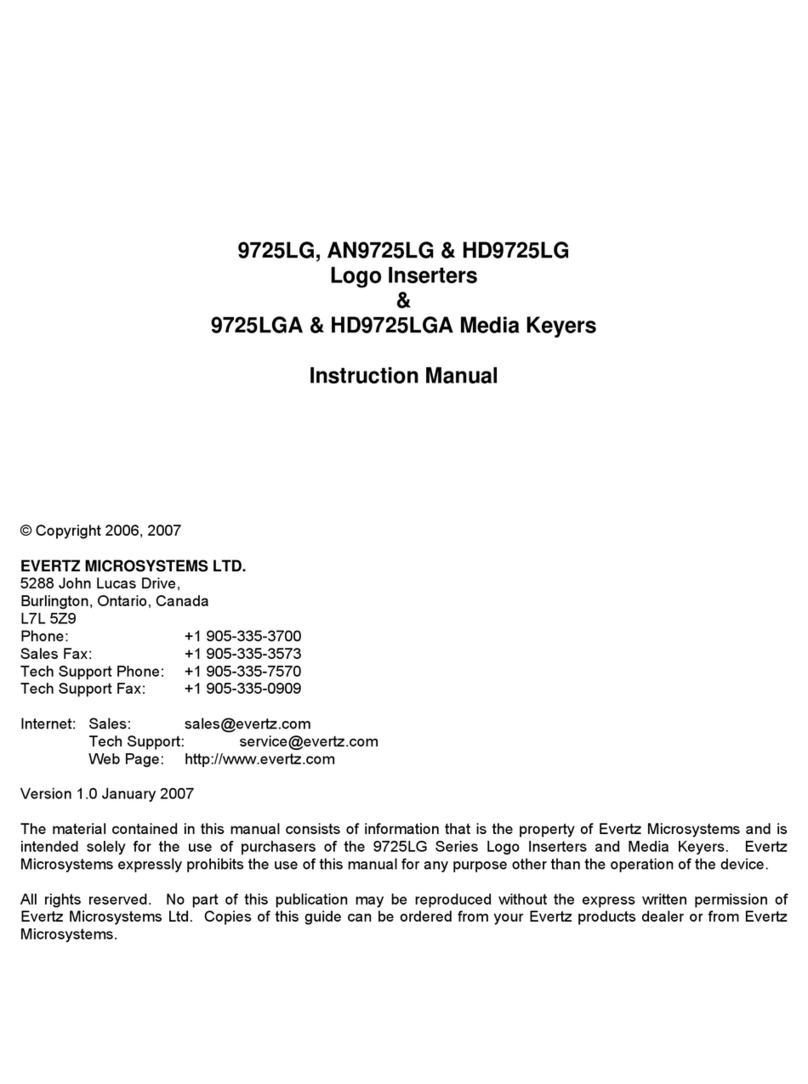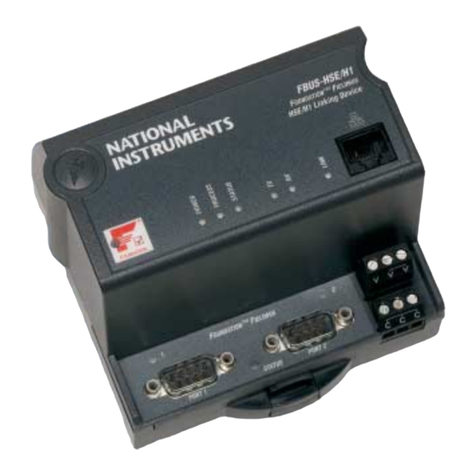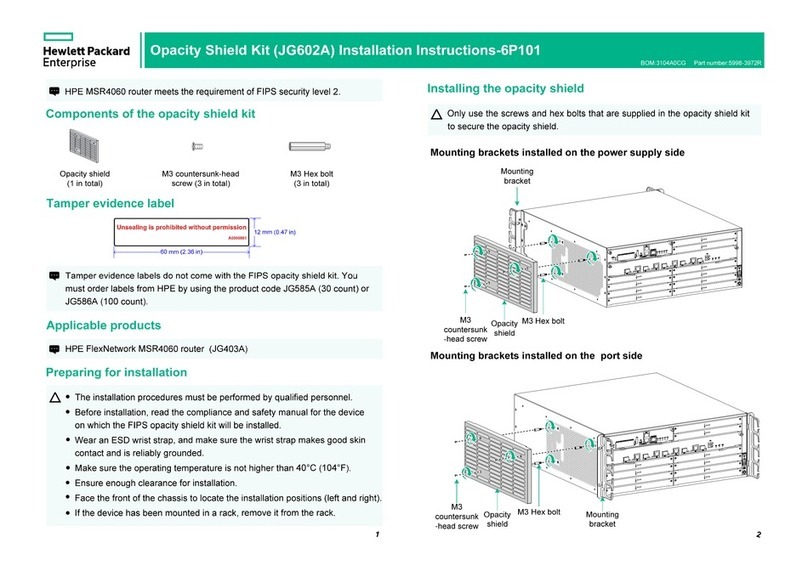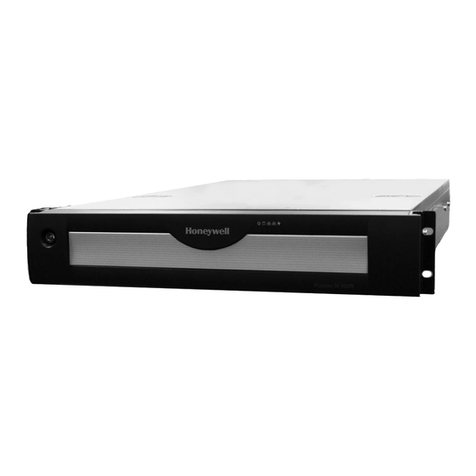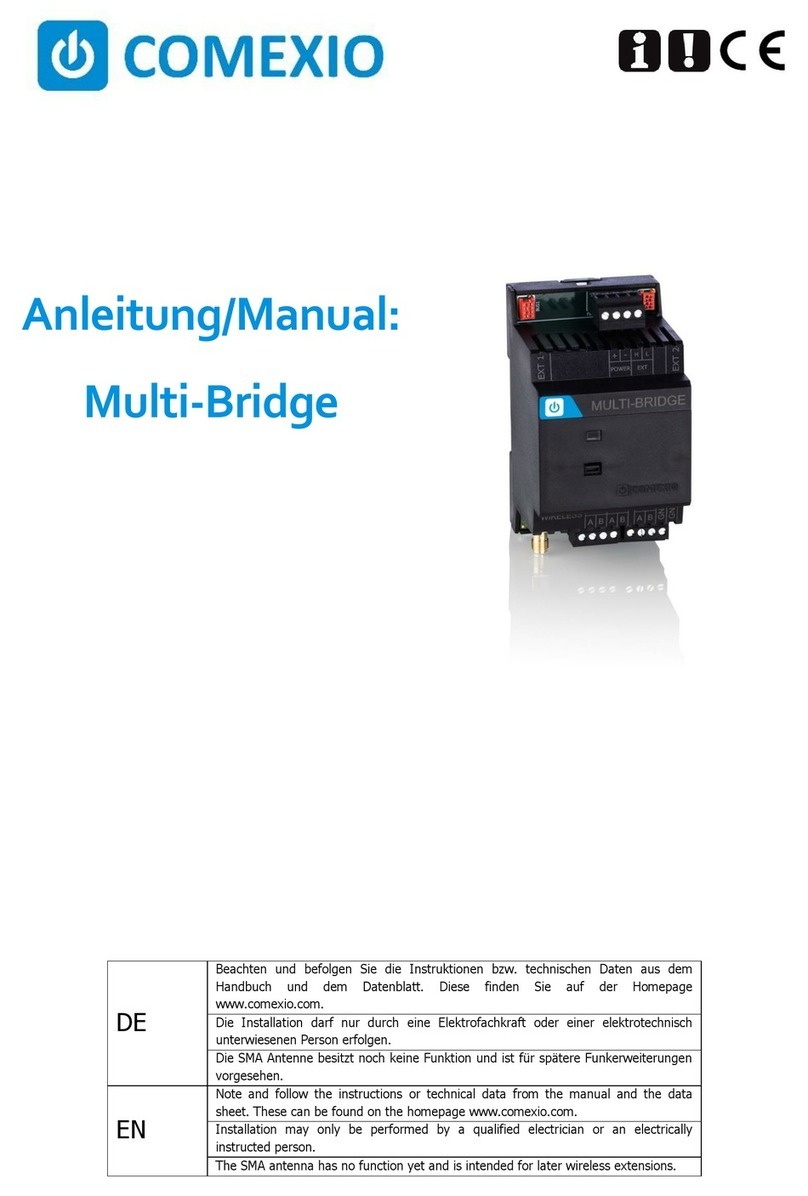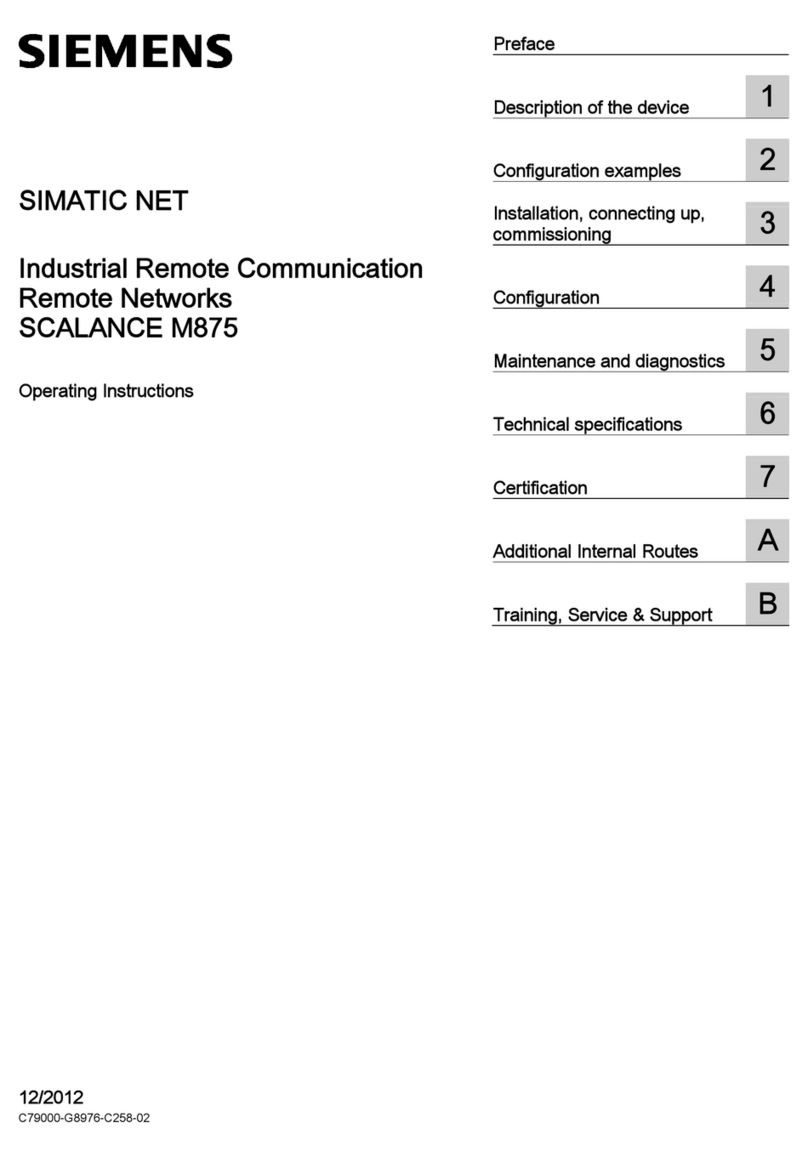Aerotech PRO22SL User manual

Revision 2.00
PRO22SL and SLEMechanical Bearing,
Ball-Screw Stage
HARDWAREMANUAL

GLOBALTECHNICALSUPPORT
Go to the Global Technical Support Portal for information and support about your
Aerotech, Inc. products. The website supplies software, product manuals, Help files,
training schedules, and PC-to-PC remote technical support. If necessary, you can
complete Product Return (RMA) forms and get information about repairs and spare or
replacement parts. To get help immediately, contact a service office or your sales
representative. Include your customer order number in your email or have it available
before you call.
This manual contains proprietary information and may not be reproduced, disclosed, or
used in whole or in part without the express written permission of Aerotech, Inc.
Product names mentioned herein are used for identification purposes only and may be
trademarks of their respective companies.
Copyright © 2008-2021, Aerotech, Inc., All rights reserved.

Table of Contents
PRO22SL and SLEMechanical Bearing, Ball-Screw Stage 1
Table of Contents 3
List of Figures 4
List of Tables 5
Safety Procedures and Warnings 7
EU Declaration of Incorporation 11
Chapter 1: Overview 13
1.1. Environmental Specifications 15
1.2. Accuracy and Temperature Effects 15
1.3. Basic Specifications 16
1.4. Vacuum Operation 18
Chapter 2: Installation 19
2.1. Unpacking and Handling the Stage 19
2.2. Dimensions 21
2.3. Securing the Stage to the Mounting Surface 25
2.4. Attaching the Payload to the Stage 26
Chapter 3: Electrical Installation 29
3.1. Motor and Feedback Connectors 30
3.2. Motor and Feedback Wiring 34
3.3. Motor and Feedback Specifications 36
3.4. Limits, Marker, and Machine Direction 40
3.5. Motor and Feedback Phasing 41
Chapter 4: Maintenance 43
4.1. Service and Inspection Schedule 43
4.2. Cleaning and Lubrication 44
4.3. Motor Mounting 48
4.4. Belt Adjustment 51
4.5. Troubleshooting 54
Appendix A: Warranty and Field Service 55
Appendix B: Revision History 57
Index 59
PRO225SL/SLE Hardware Manual Table of Contents
www.aerotech.com 3

List of Figures
Figure 2-1: Lifting Features 20
Figure 2-2: PRO225SL Dimensions 21
Figure 2-3: PRO225SLE Dimensions 22
Figure 2-4: Tabletop Accessory Dimensions (-TT3 Option) 23
Figure 2-5: Z-Axis Bracket Dimensions 24
Figure 2-6: Stage Orientations 27
Figure 2-7: Cantilevered Load Capability 27
Figure 2-8: Load Torque Equation 28
Figure 2-9: Torque Required to Turn Ball Screw in Vertical Orientation 28
Figure 3-1: Brushless Motor and Feedback Wiring [-SL Option] 34
Figure 3-2: Brushless Motor and Feedback Wiring [-SLE Option] 35
Figure 3-3: Machine Direction 40
Figure 3-4: Hall Phasing Diagram 41
Figure 3-5: Encoder Phasing Reference Diagram (Standard/Square Wave) 42
Figure 3-6: Encoder Phasing Reference Diagram (Analog/Sine Wave) 42
Figure 4-1: Hardcover Rear End Plate Removal 46
Figure 4-2: Hardcover Screw Removal 46
Figure 4-3: Hardcover Removal 47
Figure 4-4: Motor Mounting Overview 48
Figure 4-5: Attach the Coupling Adapter to the Motor Shaft 49
Figure 4-6: Attach the Motor the Stage 49
Figure 4-7: Tighten the Shaft Coupling to the Drive Screw 50
Figure 4-8: Foldback Motor Cover Removal 52
Figure 4-9: Foldback Motor Part Callouts 53
Figure 4-10: Lubricate the Pulley Flanges 53
List of Figures PRO225SL/SLE Hardware Manual
4 www.aerotech.com

List of Tables
Table 1-1: Model Numbers and Ordering Options 13
Table 1-2: Environmental Specifications 15
Table 1-3: PRO225SL/SLE Series Specifications (-0100 to -0300) 16
Table 1-4: PRO225SL/SLE Series Specifications (-0400 to -1000) 17
Table 2-1: Stage Mounting Surface Flatness Requirement 25
Table 2-2: Stage to Mounting Surface Hardware 25
Table 3-1: Brushless Motor Connector Pinout 31
Table 3-2: Mating Connector Part Numbers for the Brushless Motor Connector 31
Table 3-3: Brushless Motor Feedback Connector Pinout 31
Table 3-4: Mating Connector Part Numbers for the Brushless Motor Feedback Connector 31
Table 3-5: Linear Encoder Connector Pinout (-SLE only) 32
Table 3-6: Mating Connector Part Numbers for the Encoder Connector 32
Table 3-7: Limit Connector Wiring 33
Table 3-8: Mating Connector Part Numbers for the Limit Connector 33
Table 3-9: Hall-Effect Sensor Specifications (BM or BMSMotor Options) 36
Table 3-10: Thermistor Specifications (BMSMotor Options) 36
Table 3-11: Encoder Specifications 36
Table 3-12: Limit Switch Specifications 36
Table 3-13: Brake Specifications 36
Table 3-14: PRO225SL/SLE Motor Specifications (BMS280) 37
Table 3-15: PRO225SL/SLE Motor Specifications (BM250) 38
Table 3-16: Rotary Encoder Specifications for PRO225SL/SLEStages 39
Table 3-17: Linear Encoder Specifications forPRO225SL/SLEE Stages 39
Table 4-1: Hardware Requirements 48
PRO225SL/SLE Hardware Manual List of Tables
www.aerotech.com 5

This page intentionally left blank.
List of Tables PRO225SL/SLE Hardware Manual
6 www.aerotech.com

Safety Procedures and Warnings
IMPORTANT: This manual tells you how to carefully and correctly use and operate the
PRO225SL/SLE stage.
lRead all parts of this manual before you install or operate the PRO225SL/SLE stage or
before you do maintenance to your system.
lTo prevent injury to you and damage to the equipment, obey the precautions in this
manual.
lAll specifications and illustrations are for reference only and were complete and accurate
as of the release of this manual. To find the newest information about this product,
refer to www.aerotech.com.
If you do not understand the information in this manual, contact Aerotech Global
Technical Support.
IMPORTANT: This product has been designed for light industrial manufacturing or
laboratory environments. If the product is used in a manner not specified by the
manufacturer:
lThe protection provided by the equipment could be impaired.
lThe life expectancy of the product could be decreased.
DANGER: To decrease the risk of electrical shock, injury, death, and damage to the
equipment, obey the precautions that follow.
lRestrict access to the PRO225SL/SLE when it is connected to a power source.
lDo not connect or disconnect electrical components, wires, and cables while this product
is connected to a power source.
lBefore you do maintenance to the equipment, disconnect the electrical power.
lUncouple or otherwise prevent motor-coupled machinery movement when you do ser-
vice to the equipment.
lMake sure that all components are grounded correctly and that they obey the local elec-
trical safety requirements.
lMake sure that the motor frame is safety grounded with a conductor equal in size to the
phase conductors.
lThe drive must contain a properly-sized fuse, matched to the motor cable wire size.
lSupply each operator with the necessary protection from live electrical circuits.
PRO225SL/SLE Hardware Manual Safety Procedures and Warnings
www.aerotech.com 7

DANGER: Hot surfaces. The case temperature could exceed 70°C.
lDo not touch the motor while it is in operation.
lWait until the motor has cooled before you touch it.
DANGER: The motor is not rated for use in explosive atmospheres. Do not operate the
motor in the presence of potentially explosive mixtures of air-borne dust or combustible
vapors.
IMPORTANT: Equipment grounds must be in place and maintained to reduce the risk of
serious or potentially fatal injury from electric shock.
DANGER: Strong Magnets / Electromagnetic Fields
lMotors and their associated drive, cables, and components are sources of elec-
tromagnetic fields. Persons with implanted medical devices need to evaluate the risks
associated with these devices before they can enter an area where the devices are in use.
lStrong rare-earth magnets are present in the motor. Interaction with metallic objects
(tools, watches, or keys, for example) could produce pinch injuries or damage to the
equipment.
lUse non-magnetic tools when you do service to the motor.
DANGER: System travel can cause crush, shear, or pinch injuries. Restrict access to all
motor and stage parts while your system is connected to a power source.
lDo not put yourself in the travel path of machinery.
lMotors are capable of very high speeds and acceleration rates.
Safety Procedures and Warnings PRO225SL/SLE Hardware Manual
8 www.aerotech.com

WARNING: To decrease the risk of damage to the equipment, you must obey the
precautions that follow
lOnly trained operators should operate this equipment.
lAll service and maintenance must be done by approved personnel.
lUse this product only in environments and operating conditions that are approved in
this manual.
lNever install or operate equipment that appears to be damaged.
lOn stages with BMSmotors: the motor over-temperature sensor must be monitored by
the drive. Use it to shut down the drive if the motor overheats.
lMake sure that the product is securely mounted before you operate it.
lUse care when you move the PRO225SL/SLE or you could negatively affect the per-
formance of it.
WARNING: Securely mount and position all system cables.
PRO225SL/SLE Hardware Manual Safety Procedures and Warnings
www.aerotech.com 9

This page intentionally left blank.
Safety Procedures and Warnings PRO225SL/SLE Hardware Manual
10 www.aerotech.com

EU Declaration of Incorporation
Manufacturer Aerotech, Inc.
101 Zeta Drive
Pittsburgh, PA 15238-2811
USA
herewith declares that the product:
PRO225SL/SLE Linear Stage
is intended to be incorporated into machinery to constitute machinery covered by the Directive 2006/42/EC as
amended;
and that the following harmonized European standards have been applied:
EN ISO 12100:2010
Safety of machinery - Basic concepts, general principles for design
EN 60204-1:2010
Safety of machinery - Electrical equipment of machines - Part 1:General
requirements
and further more declares that
it is not allowed to put the equipment into service until the machinery into which it is to
be incorporated or of which it is to be a component has been found and declared to be
in conformity with the provisions of the Directive 2006/42/EC and with national
implementing legislation, for example, as a whole, including the equipment referred to
in this Declaration.
This is to certify that the aforementioned product is in accordance with the applicable requirements of the
following directive(s):
2011/65/EU RoHS 2 Directive
EU 2015/863 Amendment RoHS 3 Directive
Authorized
Representative / Simon Smith, European Director
Aerotech Ltd
The Old Brick Kiln, Ramsdell, Tadley
Hampshire RG26 5PR
UK
Engineer Verifying
Compliance / Alex Weibel
Aerotech, Inc.
101 Zeta Drive
Pittsburgh, PA 15238-2811
USA
Date 6/8/2021
PRO225SL/SLE Hardware Manual EU Declaration of Incorporation
www.aerotech.com 11

This page intentionally left blank.
EU Declaration of Incorporation PRO225SL/SLE Hardware Manual
12 www.aerotech.com

Chapter 1: Overview
The specifications in this manual pertain to the second generation of PRO SL/SLE stages. Second
generation stages can be distinguished from their first generation counterparts by the curved hardcover
on the second generation. Contact Aerotech if you need a first generation manual.
Table 1-1: Model Numbers and Ordering Options
PRO225SL and PRO225SLE Series Linear Ball-Screw Stage
Direct Linear Feedback (-SLEonly)
-E1 Incremental linear encoder; 1 Vpp
-E2 Incremental linear encoder; 0.1 µm digital RS422 output
-E3 Absolute linear encoder; EnDat 2.2
-E4 Incremental linear encoder; 0.5 µm digital RS422 output
Travel (Required)
-0100 100 mm travel stage
-0150 150 mm travel stage
-0200 200 mm travel stage
-0250 250 mm travel stage
-0300 300 mm travel stage
-0400 400 mm travel stage
-0500 500 mm travel stage
-0600 600 mm travel stage
-0800 800 mm travel stage
-1000 1000 mm travel stage
Mounting Orientation (Required)
Normal mounting orientation
-MT1 Side-mounted or vertical orientation
-MT2 Inverted mounting orientation
Tabletop (Optional for SL Stages; Required for SLE Stages)
-TT1 Tabletop with metric dimension mounting
-TT2 Tabletop with English dimension mounting
-TT3 Accessory tabletop with mounting for select rotary stages
-TT4 Tabletop with metric dimension mounting and wiper brushes
-TT5 Tabletop with English dimension mounting and wiper brushes
-TT6 Accessory tabletop with mounting pattern for select rotary stages and wipers
Motor (Optional)
-M1 BMS280 brushless servomotor and 2500-Line digital RS422 encoder
-M2 BMS280 brushless servomotor, 2500-Line digital RS422 encoder, and brake
-M3 BMS280 brushless servomotor and 1000-Line 1 Vpp encoder
-M4 BMS280 brushless servomotor, 1000-Line 1 Vpp encoder, and brake
-M5 BM250 brushless servomotor, 2500-Line 1 Vpp encoder, and brake
-M6 BM250 brushless servomotor, 2500-Line digital RS422 encoder, and brake
-M7 BM250 brushless servomotor and 1000-Line 1 Vpp encoder
-M8 BM250 brushless servomotor, 1000-Line 1 Vpp encoder, and brake
PRO225SL/SLE Hardware Manual Chapter 1: Overview
www.aerotech.com 13

PRO225SL and PRO225SLE Series Linear Ball-Screw Stage (continued)
Foldback (Optional)
-FB1 Foldback kit for 1/2" diameter shaft NEMA 34 motor
Motor Orientation (Optional)
-2 Bottom cable exit, optional orientation
-3 Left-side cable exit, standard orientation
-4 Top cable exit, optional orientation
-5 Right-side cable exit, optional orientation
-8 Right-side foldback, standard orientation
-12 Left-side foldback, optional orientation
Limits (Required)
-LI1 Normally-closed limit switches; 5 VDC with 9-pin D connector
-LI2 Normally-open limit switches; 5 VDC with 9-pin D connector
-LI3 Normally-closed limit switches; 24 VDC with 9-pin D connector
Coupling (Optional)
-CP1 Coupling for 1/2" diameter shaft
LiftingHardware (Optional)
-LF Lifting hardware
NOTE: Lifting option only available on travels 300 mm and greater. Lifting should never be ordered on the upper-axis of
an XY set (only order on lower-axis).
ThermoComp™ (Optional)
-TCMP ThermoComp™ integrated thermal compensation unit
NOTE: You must use an Automation1 or A3200 controller with the -TCMP option.
Metrology (Required)
-PL0 No metrology performance plots
-PL1 Uncalibrated with performance plots
-PL2 Calibrated with performance plots
Accessories (To be Ordered as a Separate Line Item)
ALIGN-NPA Non-precision XY assembly
ALIGN-NPAZ Non-precision XZ or YZ assembly
ALIGN-PA10 XY assembly; 10 arc sec orthogonality; alignment to within 7 µm orthogonality for short
travel stages
ALIGN-PA10Z XZ or YZ assembly with L-bracket; 10 arc second orthogonality; alignment to within 10 µm
orthogonality for short travel stages
ALIGN-PA5 XY assembly; 5 arc sec orthogonality; alignment to within 3 µm orthogonality for short
travel stages
ALIGN-PA5Z XZ or YZ assembly with L-bracket; 5 arc second orthogonality; alignment to within 5 µm
orthogonality for short travel stages
HDZ225 Right angle L-bracket for 100 mm, 150 mm, and 200 mm travels only
Chapter 1: Overview PRO225SL/SLE Hardware Manual
14 www.aerotech.com

1.1. Environmental Specifications
WARNING: Do not expose this product to environments or conditions outside of the
listed specifications. You could damage the equipment if you exceed the environmental or
operating specifications.
Table 1-2: Environmental Specifications
Ambient
Temperature
Operating: 10° to 35° C (50° to 95° F)
The optimal operating temperature is 20° C ±2° C (68° F ±4° F). If at any time the
operating temperature deviates from 20° C degradation in performance could
occur.
Storage: 0° to 40° C (32° to 104° F) in original shipping packaging
Humidity Operating: 20% to 60% RH
Storage: 10% to 70% RH, non-condensing in original packaging.
The stage should be packaged with desiccant if it is to be stored for an extended
time.
Altitude Operating: 0 m to 2,000 m (0 ft to 6,562 ft) above sea level
Contact Aerotech if your specific application involves use above 2,000 m or below
sea level.
Vibration Use the system in a low vibration environment. Excessive floor or acoustical
vibration can affect system performance. Contact Aerotech for information
regarding your specific application.
Protection
Rating
The PRO225SL/SLE stages have limited protection against dust, but not water. This
equates to an ingress protection rating of IP50.
Use Indoor use only
1.2. Accuracy and Temperature Effects
The accuracy specification of series stages is measured 25 mm above the table with the stage in an
unloaded condition. The stage is assumed to be fully supported by a mounting surface meeting or
exceeding the specification in Section 2.3.
The accuracy of the screw is a key element in the overall positioning accuracy of the SLstage. A scale
error can be expected if temperature of the screw differs from 20° C (68° F). The greater the
temperature difference, the greater the error. The temperature of the screw depends on the speed and
duty cycle of the stage. The faster the movement and higher the duty cycle, the more the stage accuracy
will be affected by heat. The thermal expansion coefficient of the screw is 11.7 ppm/°C.
SLEstages contain a linear encoder for direct feedback of the carriage position. The stage travel as seen
by the linear encoder will expand at the rate of 3.25 ppm/°C as the temperature of the encoder scale
deviates from 20°C.
The ThermoComp™ option is a hardware and software solution that uses the functionality of the
Automation1 or A3200 controller to mitigate the effects of changing temperature by detecting and
compensating for thermal changes. ThermoComp™ is effective at compensating for both self-heating
and environmental temperature changes.
PRO225SL/SLE Hardware Manual 1.1. Environmental Specifications
www.aerotech.com 15

1.3. Basic Specifications
Resolution is dependent on screw pitch, encoder resolution, and controller interpolation.
Table 1-3: PRO225SL/SLE Series Specifications (-0100 to -0300)
-0100 -0150 -0200 -0250 -0300
Travel 100 mm 150 mm 200 mm 250 mm 300 mm
Accuracy (1)
SL Standard ±6 µm ±7 µm ±8 µm ±9 µm ±9.5 µm
Calibrated ±1 µm ±1 µm ±1 µm ±1.5 µm ±1.5 µm
SLE Standard ±4 µm ±6 µm ±8 µm ±9 µm ±10 µm
Calibrated ±1 µm
Resolution
(Minimum
Incremental
Motion)
SL 0.1 µm (2), 1.0 µm (3)
SLE 0.05 µm (-E1/-E3 encoder), 0.2 µm (-E2 encoder), 1.0 µm (-E4
encoder)
Bidirectional
Repeatability (1)
SL ±1 µm
SLE ±0.5 µm
Horizontal Straightness (1) ±2 µm ±2.5 µm ±2.5 µm ±3 µm ±3.5 µm
Vertical Straightness (1) ±2 µm ±2.5 µm ±2.5 µm ±3 µm ±3.5 µm
Pitch 29 µrad
(6 arc·sec)
29 µrad
(6 arc·sec)
39 µrad
(8 arc·sec)
49 µrad
(10.1
arc·sec)
50 µrad
(10.3
arc·sec)
Roll 29 µrad
(6 arc·sec)
29 µrad
(6 arc·sec)
39 µrad
(8 arc·sec)
49 µrad
(10.1
arc·sec)
50 µrad
(10.3
arc·sec)
Yaw 29 µrad
(6 arc·sec)
29 µrad
(6 arc·sec)
39 µrad
(8 arc·sec)
49 µrad
(10.1
arc·sec)
50 µrad
(10.3
arc·sec)
Maximum Speed (4) 220 mm/s
Maximum Acceleration (4) Function of motor, amplifier, payload, and maximum axial load
Load Capacity (5)
Horizontal 100 kg
Vertical (Axial) 60 kg
Side 100 kg
Moving Mass
(with tabletop)
SL 7.3 kg
SLE 7.5 kg
Stage Mass
(no motor)
SL 19.8 kg 21.0 kg 22.2 kg 23.3 kg 24.5 kg
SLE 20.5 kg 21.7 kg 22.9 kg 24.1 kg 25.3 kg
Material Anodized Aluminum
Mean Time Before Failure (MTBF) 20,000 Hours
1. Certified with -PL1 and -PL2 option.
2. Achieved with Aerotech rotary motor with amplified sine encoder.
3. Achieved with Aerotech rotary motor with 2500 counts/rev digital encoder.
4. Requires the selection of an applicable amplifier with sufficient voltage and current.
5. Axis orientation for on-axis loading is listed.
6. Specifications are for single-axis systems measured 25 mm above the tabletop; performance of multi-axis system is
payload and workpoint dependent. Consult the Aerotech factory for multi-axis or non-standard applications.
7. Specifications listed are non-foldback kit options. Contact the factory for specifications when a foldback kit (-FBx) is
used.
1.3. Basic Specifications PRO225SL/SLE Hardware Manual
16 www.aerotech.com

Table 1-4: PRO225SL/SLE Series Specifications (-0400 to -1000)
-0400 -0500 -0600 -0800 -1000
Travel 400 mm 500 mm 600 mm 800 mm 1000 mm
Accuracy (1)
SL Standard ±11 µm ±13 µm ±15 µm ±17 µm ±18 µm
Calibrated ±1.5 µm ±2 µm ±2 µm ±2.5 µm ±3 µm
SLE Standard ±12 µm ±14 µm ±15.5 µm ±17 µm ±18 µm
Calibrated ±1 µm ±1.5 µm ±1.5 µm ±1.5 µm ±1.5 µm
Resolution
(Minimum
Incremental
Motion)
SL 0.1 µm (2), 1.0 µm (3)
SLE 0.05 µm (-E1/-E3 encoder), 0.2 µm (-E2 encoder), 1.0 µm (-E4
encoder)
Bidirectional
Repeatability (1)
SL ±1 µm
SLE ±0.5 µm ±0.5 µm ±0.5 µm ±0.75 µm ±0.75 µm
Horizontal Straightness (1) ±4.5 µm ±5.5 µm ±6.5 µm ±8 µm ±9.5 µm
Vertical Straightness (1) ±4.5 µm ±5.5 µm ±6.5 µm ±8 µm ±9.5 µm
Pitch
60 µrad
(12.4
arc·sec)
70 µrad
(14.4
arc·sec)
80 µrad
(16.5
arc·sec)
90 µrad
(18.6
arc·sec)
110 µrad
(22.7
arc·sec)
Roll
60 µrad
(12.4
arc·sec)
70 µrad
(14.4
arc·sec)
80 µrad
(16.5
arc·sec)
90 µrad
(18.6
arc·sec)
110 µrad
(22.7
arc·sec)
Yaw
60 µrad
(12.4
arc·sec)
70 µrad
(14.4
arc·sec)
80 µrad
(16.5
arc·sec)
90 µrad
(18.6
arc·sec)
110 µrad
(22.7
arc·sec)
Maximum Speed (4) 220 mm/s 220 mm/s 220 mm/s 220 mm/s 140 mm/s
Maximum Acceleration (4) Function of motor, amplifier, payload, and maximum axial load
Load Capacity (5)
Horizontal 100 kg
Vertical (Axial) 60 kg
Side 100 kg
Moving Mass
(with tabletop)
SL 7.3 kg
SLE 7.5 kg
Stage Mass
(no motor)
SL 26.9 kg 29.2 kg 31.5 kg 36.2 kg 40.9 kg
SLE 27.8 kg 30.2 kg 32.6 kg 37.5 kg 42.3 kg
Material Anodized Aluminum
Mean Time Before Failure (MTBF) 20,000 Hours
1. Certified with -PL1 and -PL2 option.
2. Achieved with Aerotech rotary motor with amplified sine encoder.
3. Achieved with Aerotech rotary motor with 2500 counts/rev digital encoder.
4. Requires the selection of an applicable amplifier with sufficient voltage and current.
5. Axis orientation for on-axis loading is listed.
6. Specifications are for single-axis systems measured 25 mm above the tabletop; performance of multi-axis system is
payload and workpoint dependent. Consult the Aerotech factory for multi-axis or non-standard applications.
7. Specifications listed are non-foldback kit options. Contact the factory for specifications when a foldback kit (-FBx) is
used.
PRO225SL/SLE Hardware Manual 1.3. Basic Specifications
www.aerotech.com 17

1.4. Vacuum Operation
There are two vacuum preparation options:
lLow Vacuum (for use in atmospheric pressures to 10-3 Torr)
lHigh Vacuum (preparation for environments from 10-3 to 10-6 Torr).
Special preparations include:
lParts are lubricated with vacuum-compatible lubricants.
lMaterials, fasteners, and coatings with vacuum outgas performance are ensured to be compatible
with the specified level of vacuum.
lFor high vacuum systems, situations that may allow gases to become temporarily trapped during
pump down are removed.
lPrior to assembly, stage parts are thoroughly cleaned in a clean environment.
lThe stage is packaged in a special polyethylene bag.
Vacuum Guidelines
To ensure that the stage will continue to perform well in the vacuum environment, follow the guidelines
listed below (in addition to standard handling, installation, and lubrication guidelines outlined in this
manual).
1. Do not remove the stage from its sealed bag until it is ready for use.
2. Always handle the stage in a clean environment and use powder-free polyethylene gloves to prevent
any contaminants from adhering to the surface of the stage.
3. During installation, use cleaned, vented, stainless steel fasteners to secure the stage.
4. Reduced air pressure eliminates significant convective heat transfer. This, coupled with the viscous
vacuum-compatible lubricants, could result in excessive motor operating temperatures. Because of
this, consider all continuous torque ratings to be 40 to 60% lower than the value specified for oper-
ation in normal atmospheric environment. Reduce motor usage accordingly.
5. We recommend that you use a small quantity of Braycote® 602EF grease or a compatible substitute
of equal quality lubricant in vacuum applications.
6. Bake vacuum components at 60 °C for 24 to 48 hours to significantly reduce outgassing at initial
pump-down to vacuum pressure and evaporate water vapor that impregnates porous surfaces on the
aluminum and Teflon cables. Aerotech recommends that customers bake out vacuum systems when
first installing them in the vacuum chamber. Contact Aerotech to discuss your application and the
recommended bakeout procedure.
1.4. Vacuum Operation PRO225SL/SLE Hardware Manual
18 www.aerotech.com

Chapter 2: Installation
WARNING: PRO225SL/SLE installation must be in accordance to instructions provided by
this manual and any accompanying documentation. Failure to follow these instructions
could result in injury or damage to the equipment.
2.1. Unpacking and Handling the Stage
WARNING:HEAVY! It is the responsibility of the customer to safely and carefully lift and
move the PRO225SL/SLE.
lRefer to Section 1.3. for stage mass specifications. Do not attempt to lift heavy loads
single handed.
lUse care when you move the PRO225SL/SLE or you could negatively affect the per-
formance of it.
lLift this product only by the base.
lUse a cart, dolly, or similar device to move the stage to a new location.
lFor multi-axis assemblies, always lift the system by the lower axis.
lDo not use the cables or the connectors to lift or move this product.
lMake sure that all moving parts are secure before you move the PRO225SL/SLE. Unse-
cured moving parts could shift and cause injury or damage to the equipment.
Carefully remove the stagefrom its protective shipping container. Gently set the stage on a smooth, flat,
and clean surface. Use compressed nitrogen or clean, dry, oil-free air to remove any dust or debris that
has collected during shipping.
Before you operate the stage, let it stabilize at room temperature for at least 12 hours. This will ensure
that all of the alignments, preloads, and tolerances are the same as they were when they were tested at
Aerotech.
Each stage has a label listing the system part number and serial number. These numbers contain
information necessary for maintenance or system hardware and software updates. Locate this label and
record the information for later reference.
PRO225SL/SLE Hardware Manual Chapter 2: Installation
www.aerotech.com 19

Lifting Features
The lifting kit includes four eyebolts and four standoffs. Thread the eyebolts onto the standoffs and
thread the standoffs into the stage base. Remove the lifting hardware by turning a wrench on the flats
of the standoffs (see Figure 2-1). If the stage is part of a multi-axis system, the lifting hardware should be
attached to the lower axis. The lifting hardware must be removed before the stage can be operated.
Figure 2-1: Lifting Features
2.1. Unpacking and Handling the Stage PRO225SL/SLE Hardware Manual
20 www.aerotech.com
This manual suits for next models
1
Table of contents
Other Aerotech Network Hardware manuals
